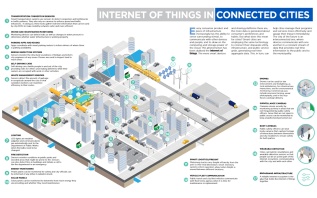No.
 2017 is not the year for Big Change in city, county or state tech. I’d argue NO year is a year for “Big Change” in the technologies used by government. Government does not change fast, which may be a Good Thing.
2017 is not the year for Big Change in city, county or state tech. I’d argue NO year is a year for “Big Change” in the technologies used by government. Government does not change fast, which may be a Good Thing.
Civic Technology – the information technologies used by local, state and federal governments – typically plod along many years behind commercial adoption of technology and a decade or more behind the latest, leading edge, advances in tech.
Here are some examples: commercial companies go whole hog to adopt cloud technologies while government still operates data centers and even builds new ones (State of Washington, 2014). Consumers and commercial companies adopt the iPhone; government still uses the Blackberry or (Congress and President Obama finally ditched them in 2016) or doesn’t even issue smart phones to its first responders. Commercial companies adopt agile development, with sprints that update apps every few weeks; governments still do “big” multi-year projects which invariably go over budget and implement years later than planned, often with semi-disastrous consequences.
Stephen Goldsmith, Director of Innovation in Government at the Harvard Kennedy School and former Mayor of Indianapolis, believes 2017 will be the year for technology breakthroughs in government such as virtual assistants, artificial intelligence, chatbots, natural language processing (think Alexa, Siri or Cortana), machine-to-machine communications and predictive analytics.
I’m not so sure.
Or rather, I am virtually certain 2017 will NOT be the year for chatbots, artificial intelligence and natural language processing. I’m pretty sure we won’t get very wide adoption of predictive analytics, especially given the recent implosion of “predictive policing”.
There are a number of reasons for my skepticism, but that’s a topic for a different post.
Ok, so if I’m certain no one will be saying “Alexa, pay my parking ticket” in 2017, what technologies will governments be adopting?
 Smart Cities. Cities are finally networking their sensors and harnessing the Internet of Civic Things (IoCT) to improve transportation, public safety, and quality of life. Kansas City, Missouri, led by a gutsy Mayor Sly James and Chief Innovation Officer Bob Bennett, along with networking vendor Cisco, is leading this charge with LED street lights, transportation signal timing and tracking, and a smart city map. Former Mayor Mark Funkhouser, now publisher of Governing Magazine, also deserves credit for his innovative leadership style, as does Google Fiber, for making KCMO its launch city. Boston will not be far behind as it received 104 responses from 85 companies for its smart city RFI, one of which includes outfitting the city with 15,000 smart street lights. And Columbus, Ohio, has the right idea – using tech to help people – rather than tech for tech’s sake – as it uses its Smart City Challenge Grant to try and reduce deaths of infants and connect low-income residents to jobs.
Smart Cities. Cities are finally networking their sensors and harnessing the Internet of Civic Things (IoCT) to improve transportation, public safety, and quality of life. Kansas City, Missouri, led by a gutsy Mayor Sly James and Chief Innovation Officer Bob Bennett, along with networking vendor Cisco, is leading this charge with LED street lights, transportation signal timing and tracking, and a smart city map. Former Mayor Mark Funkhouser, now publisher of Governing Magazine, also deserves credit for his innovative leadership style, as does Google Fiber, for making KCMO its launch city. Boston will not be far behind as it received 104 responses from 85 companies for its smart city RFI, one of which includes outfitting the city with 15,000 smart street lights. And Columbus, Ohio, has the right idea – using tech to help people – rather than tech for tech’s sake – as it uses its Smart City Challenge Grant to try and reduce deaths of infants and connect low-income residents to jobs.
- Free public Wi-Fi. This was a totally stupid idea when it first surfaced in Philadelphia in 2004, and died a slow, lingering death there and in a hundred other cities across the nation. But now, with advent of smart street lights, well-developed municipal fiber networks, and the whole concept of “smart cities”, the idea has come of age. If a city is already connecting its parking kiosks, street lights, public buildings and other infrastructure to the network, popping up “free” public wi-fi is trivial. New York City’s LinkNYC, after it fixed its porn problem, is starting to be quite successful, with 600+ kiosks enabled. Kansas City is using its smart city platform to provide Wi-Fi to 50 blocks in the downtown area.
- Cloud computing. Governments have been extraordinarily reluctant to get rid of their dinosaur data centers. The move to the cloud is actually accelerating now, led by initiatives such as body-worn video storage in Taser’s evidence.com, for example, which is hosted by Microsoft in its Azure cloud. But, as a matter of fact, many other cloud based solutions are being adopted by government such as NeoGov for human resources, Accela for licensing, permitting and finance, and Workday for human resources and financial management. In many cases the line departments (utilities, public works, permitting, public safety) of governments acquire these cloud solutions, either with the support of their IT departments or despite them.
- U
 nhumaned aerial vehicles – UAVs or Drones. Drones seem to have suddenly exploded on the scene a couple of years ago when the technology was ripe, although radio-controlled aircraft have been around for decades. Now, however, governments have discovered the tremendous usefulness of these aircraft, far beyond the military applications. North Carolina’s Department of Transportation is working with other agencies to use drones in crises ranging from flooding to traffic collisions. Use of drones in search-and-rescue (SAR) is becoming so commonplace there is even an organization of 1,100 SAR drone pilots, which goes by the name of SWARM. Both police and fire agencies are using drones for searches, observing major fires to guide firefighting, and other purposes. We will see a major expansion of use in 2017.
nhumaned aerial vehicles – UAVs or Drones. Drones seem to have suddenly exploded on the scene a couple of years ago when the technology was ripe, although radio-controlled aircraft have been around for decades. Now, however, governments have discovered the tremendous usefulness of these aircraft, far beyond the military applications. North Carolina’s Department of Transportation is working with other agencies to use drones in crises ranging from flooding to traffic collisions. Use of drones in search-and-rescue (SAR) is becoming so commonplace there is even an organization of 1,100 SAR drone pilots, which goes by the name of SWARM. Both police and fire agencies are using drones for searches, observing major fires to guide firefighting, and other purposes. We will see a major expansion of use in 2017.
- Body-worn video (BWV). Body-worn video burst on the scene after the Ferguson, Missouri, riots, with many police departments adopting them quickly, without thinking about the privacy and policy implications. We will not only see improved policy controls, but also see wider use of BWV for officers and detectives to walk around and describe serious auto collisions and crime scenes in great detail, easing investigation and prosecution. While the original reason for use of BWV was making police officers more accountable, we’re also seeing increased professionalism, decreased liability (fewer sustained complaints) and better investigations, according to work done by Dr. David Makin of Washington State University. In 2017 more law enforcement agencies will realize these benefits, along with, of course, an increased workload for officers, detectives and prosecutors.
But how about those predictions of chatbots, virtual assistants, natural language processing and artificial intelligence?
Well, these technologies are all linked. Natural language processing (“Alexa”) allows humans to easily communicate to virtual assistants, which, in turn, can engage artificial intelligence like IBM’s Watson, Google Tensorflow or Microsoft’s Scattershot (my reference to the significant work Microsoft is doing, but not necessarily tied into a single AI engine).
 But it will take significant time for these engines to be linked to civic problems. Las Vegas is writing some skills for Alexa and New York City would like to harness Watson for its 311 center. But, like everything else in government, don’t expect a “Big Change” to suddenly happen, but rather an evolutionary development and adoption of these technologies.
But it will take significant time for these engines to be linked to civic problems. Las Vegas is writing some skills for Alexa and New York City would like to harness Watson for its 311 center. But, like everything else in government, don’t expect a “Big Change” to suddenly happen, but rather an evolutionary development and adoption of these technologies.
With some luck, sometime in the near future, there will be a Sherlock AI for helping detectives solve crimes and a Bob-the-Builder AI for helping people navigate the myriad building and zoning regulations of a modern city and similar ways that AI linked to natural language processing and personal assistants or chatbots help city residents.
But not in 2017.



Could 2018 be the year of virtual assistants. Have you heard of Voicera, featuring EVA? EVA is a voice-activated, in-meeting assistant that listens, takes notes and identifies action items & decisions in your meetings. EVA makes collaboration in the meeting easy. Find out more today http://bit.ly/2Ddu2Ja.